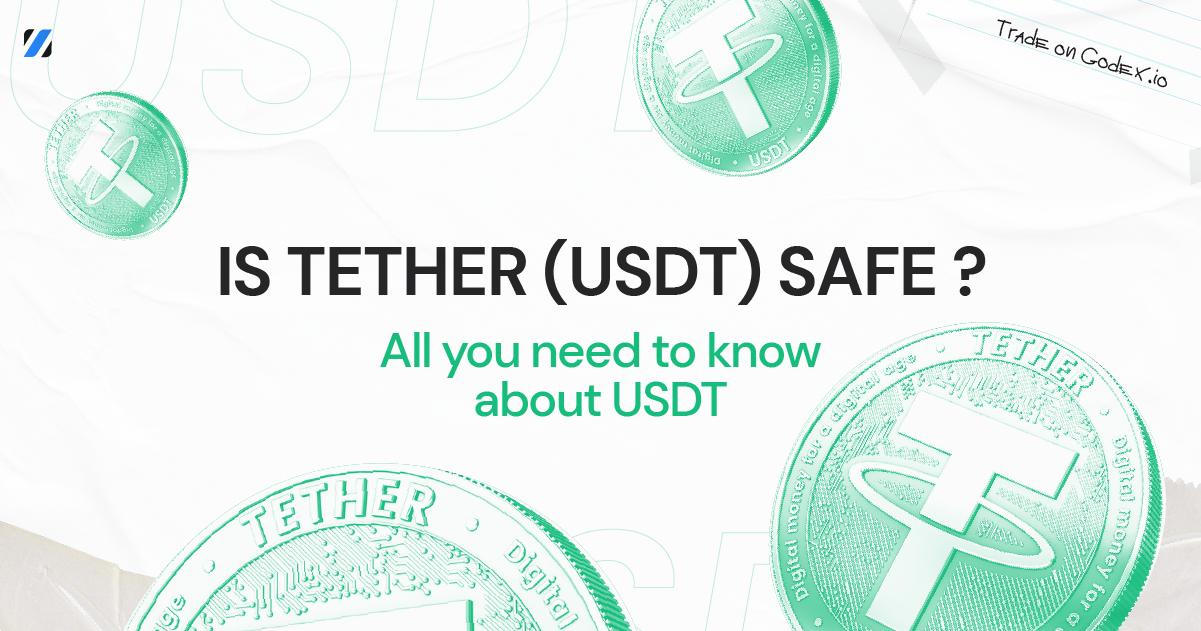Table of Contents
What Is Tether?
In the coin rankings, only Bitcoin and Ethereum managed to get ahead of Tether. It has a market capitalization of over $65 billion and an intraday trading volume across exchanges of around $56 billion. The numbers and rank, of course, indicate the interest of traders in USDT. But despite that, not everything is so good with such a popular token, the credibility of which has recently been greatly shaken. But first things first.
How Does USDT Work?
Although Tether is a crypto asset, it is nevertheless very different from coins like Bitcoin and Ethereum. While other crypto assets are virtually unbacked, resulting in increased volatility, Tether is one of the stablecoins, which means that it is pegged to a fiat currency, in this case the US dollar.
For those who are used to investing in tangible fiat currency and are afraid to invest in digital currency for fear of losing everything if the asset depreciates, Tether may seem like a great alternative. And it’s true, because it actually plays the role of a dollar on a blockchain.
Tether is pegged to a dollar 1:1 and is always redeemable for a dollar. In practice, this means that a new USDT coin can only be minted by adding $1 to a special bank account. This principle of operation helps Tether to maintain a stable price, which can only be affected by inflation.
Tether: Is It Just Stablecoin?
Tether is one of the representatives of stablecoins. Yet, in terms of market cap, it is the biggest one. Most Bitcoin transactions involve Tether. This means the failure of an asset like Tether, which is ranked third in the crypto ranking, will shake the entire digital market.
The Different Tether Versions
Tether is a coin that performs well on multiple blockchains. The most requested versions are USDT ERC20 for the Ethereum blockchain and TRC20 for the Tron blockchain.
The difference between these versions is related to the properties underlying a blockchain that hosts Tether. Often these include: security, speed and cost of transactions, as well as earning opportunities.
Most investors prefer the Ethereum network to store their Tethers as they can be useful in DeFi for passive income. Traders are more likely to favor the TRC20 version, as the Tron network has a high transaction speed – often less than a minute.
The version of USDT for Bitcoin Omni is considered the most secure and immutable. Although, in fact, the biggest risk has nothing to do with the version of Tether that an investor owns.
Is USDT Coin Safe?
It is fair to say that no crypto can be considered 100% safe. Tether is no exception. However, something happened that undermined the credibility of the digital asset and disappointed investors, who sincerely believed that the stability of the USDT coin was backed by a hard and indestructible currency.
- Is Tether really fully backed by dollars?
Recall that each USDT coin is supposed to be backed by $1. How disappointed the community was when the attestation exposed that only a few percent of Tether was backed by cash, actual dollars. While the largest share is guaranteed by mysterious commercial papers that the company’s management doesn’t want to talk about. It is only known that commercial paper is a type of short-term loan that is provided to corporations.
What did Tether do to allay the concerns? Hardly nothing. They changed their language from “100% backed one-to-one by USD” to “100% backed one-to-one by our reserves”. But “reserves” are not completely US dollars, right? The public had many questions for Tether.
CNBC TechCheck’s Deirdre Bosa interviewed Tether’s CTO Paolo Ardoino and General Counsel Stuart Hoegner, giving them a chance to redeem themselves by lifting the curtain of secrecy hanging over the reserves issue. But, alas, all they appealed to was a market capitalization growth value of over 3,000% and 24-hour trading on the exchanges which dwarfs the competition. Also, they noticed that no one has ever been denied a withdrawal from Tether.
Regarding questions about commercial paper, they were adamant, saying only that they respect the confidentiality of their banking partners and do not disclose them. Even the interviewer’s request to tell at least something about the papers, without disclosing the partners, was ignored.
- What can go wrong?
To begin with, it is necessary to understand that Tether is essentially a bank. It collects “real” (fiat) dollars from people, which form its assets, and in return issues USDT (“digital” dollars), which are its liabilities.
To earn profit, Tether does not just hold dollars, but invests them in various “profitable” assets. Income generation is usually associated with taking risks. For example, sometimes, issued loans cease to be repaid, and the volume of liabilities begins to exceed the volume of available assets.
With real banks, which are very tightly regulated by the government, this situation becomes common knowledge rather quickly. This usually causes the so-called bank run, when everyone is trying to get their money out of this bank as quickly as possible – after all, it is clear that if there are not enough assets for everyone, then by all means you must not be “the last guy who came for money”.
But Tether is not a real bank! Nobody regulates it, and it is not obliged to issue these detailed reports. Instead, it publishes a rather vague “reserves report” quarterly, which is not fully audited but limited to an offshore auditor.
To sum up the saddest scenario, if all USDT investors suddenly want to withdraw their money, most likely not everyone will manage to do it, due to the fact that a large part of the stablecoins is backed by some papers, not a dollar.
- Fraud Suspicion and Investigations
Tether’s ambiguity and lack of frankness has led the government to “take an interest” in the company. In July 2021, the US Department of Justice began an audit of the company’s management, and another US agency, the Commodity Futures Trading Commission, fined Tether $41 million in October 2021 for false information about the security of the token.
Some companies have also emerged offering rewards of up to $1 million for stablecoin collateral data.
A Bloomberg investigation exposed that the billions of dollars in Tether’s reserves are short-term loans to large Chinese companies.
Given the above, everyone must decide for themselves whether USDT is safe.
Tether is a Good Investment?
This is a difficult question, as it all depends on your goals and, as strange as it sounds, good luck. One can safely conclude that Tether is not the best crypto for long-term investment.
Firstly, a stablecoin is unlikely to make a profit, as it can be with a regular high-volatility crypto. Therefore, it is hardly reasonable to invest in it in order to earn on the difference in the exchange rate.
Secondly, at the moment there are a number of factors in the market that significantly increase the likelihood of problems for Tether if bad assets are hidden inside their opaque balance sheet.
Given the size of the company, including market cap and trading volumes, Tether is unlikely to collapse tomorrow, but it is better not to hold any significant USDT amounts in your portfolio. For these purposes, there are other more reliable, though not so widespread, stablecoins.
Should You Use Tether?
The USDT stablecoin can be used for a quick intraday trade, or for short-term exchange operations. Whereas, the arguments not to use it as a long-term investment are more than enough.
Can USDT ever Crash?
Yes, USDT can crash like any other crypto asset. If the assets backing the Tether turn out to be unreliable and the borrowers refuse to repay the loan, this is a very plausible scenario.
However, given the size of the company and the fact that Tether has managed to become one of the top three cryptocurrencies even with a small hole in the balance sheet, the crash is unlikely to happen quickly.
Get
Start a Cryptocurrency exchange. Try our crypto exchange platform
Summary
USDT is a truly unique asset and a perfect option for digital commerce. Tether is the leader among other stablecoins, and of all the cryptocurrencies, only Bitcoin and Ethereum have surpassed it.
The key issue of the project is its lack of frankness and transparency. We do not know and do not fully understand what is happening inside its balance sheet, and the unwillingness of the company’s management to shed light on this issue further discourages investing in this stablecoin.
We can only hope for the long-awaited promise of a full-fledged independent audit of the company. In the meantime, Tether is only safe for short-term transactions.
The Different Tether Versions
Tether is a coin that performs well on multiple blockchains. The most requested versions are USDT ERC20 for the Ethereum blockchain and TRC20 for the Tron blockchain.
Disclaimer: Please keep in mind that the content of this article is not financial or investing advice. The information provided is the author’s opinion only and should not be considered as direct recommendations for trading or investment. Any article reader or website visitor should consider multiple viewpoints and become familiar with all local regulations before cryptocurrency investment. We do not make any warranties about reliability and accuracy of this information.
 Alex Tamm
Alex Tamm 
Read more
Ripple (XRP) price has been widely discussed by the cryptocurrency community since it has gained public interest in 2017, even though it was founded by Chris Larsen and Jed McCaleb years before. The platform offers innovative blockchain solutions for the banking sector and has the potential to disrupt the whole finance industry. In recent years, […]
In this article we will talk about Ripple (XRP) and its price prediction. What is Ripple (XRP) Ripple is a San Francisco-based startup that was launched in 2012 by Ripple Labs as a global network both for cross-currency and gross payments. Ripple history began in 2004 with the discussions around the digital coin in the […]
You may well think that an article dedicated to a Tether price prediction or the Tether price in general is a little bit strange — it is a stablecoin after all. However, the price of Tether does fluctuate significantly, although it is nowhere near as volatile as non-stablecoin cryptos. This means that staying up to […]
In the article we share our vision at Zcash cryptocurrency main features and add several price predictions. As cryptocurrencies gain global acceptance and decentralisation slowly enters our lives, privacy becomes the main concern when talking about blockchain adoption. It is no secret that distributed ledger is by far the most secure and transparent technology ever […]
Chiliz coin (CHZ) offers a compelling opportunity for traders interested in the intersection of blockchain technology and sports. By enabling fans to influence team decisions through the Socios app, Chiliz directly monetizes fan engagement and connects with major sports teams like Juventus and Paris Saint-Germain. These partnerships not only enhance the platform’s visibility but also […]
The exponential growth of Bitcoin Satoshi Vision (BSV) against the general bear trend on the cryptocurrency market in autumn 2019 has impressed the community. Due to the increasing market capitalization, the newly emerged altcoin was ranked 5th on CoinMarketCap and managed to maintain its high position at the beginning of 2020. In the article we […]